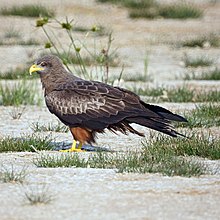Yellow-billed Kite
| Yellow-billed Kite | |
|---|---|
 | |
| In Limpopo, South Africa | |
| Scientific classification | |
| Kingdom: | Animalia |
| Phylum: | Chordata |
| Class: | Aves |
| Order: | Falconiformes (or Accipitriformes, q.v.) |
| Family: | Accipitridae |
| Genus: | Milvus |
| Species: | M. aegyptius |
| Binomial name | |
| Milvus aegyptius Gmelin, 1788 | |
| Subspecies | |
| |
The Yellow-billed Kite (Milvus aegyptius) is the Afrotropic counterpart of the Black Kite (Milvus migrans), of which it is most often considered a subspecies. However, recent DNA studies suggest that the Yellow-billed Kite differs significantly from Black Kites in the Eurasian clade, and should be considered as a separate, allopatric species.
There are two subspecies: M. a. parasitus, found throughout most of sub-Saharan Africa (including Madagascar), except for the Congo Basin (with intra-African migrations) and M. a. aegyptius of Egypt, south-west Arabia and the Horn of Africa (which disperses south during the non-breeding season).
Description
As suggested by its name, the Yellow-billed Kite is easily recognized by its entirely yellow bill, unlike that of theBlack Kite (which is present in Africa as a visitor during the North Hemisphere winter). However, immature Yellow-billed Kites resemble the corresponding age of the Black Kite.
Status
It is mostly an intra-African breeding migrant, present inSouthern Africa July–March and sometimes as late as May. It is generally common.



No comments:
Post a Comment